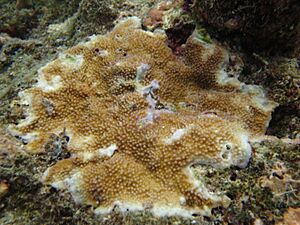Acropora palmerae facts for kids
Quick facts for kids Acropora palmerae |
|
|---|---|
 |
|
| Conservation status | |
| Scientific classification | |
| Synonyms | |
|
Acropora palmerae is a type of coral that belongs to the Acroporidae family. It lives in warm, shallow waters in many parts of the Pacific Ocean and Indian Ocean. This coral was first described by a scientist named Wells in 1954.
Contents
What Does Acropora Palmerae Look Like?
This coral forms colonies that are often encrusted, meaning they grow like a crust over rocks. From this base, they grow irregular branches. These colonies can grow quite large, sometimes reaching over 1 meter (about 3 feet) across.
The small cups where the coral polyps live are called corallites. The main ones, called axial corallites, are easy to see but don't always look the same. The other corallites, called radial corallites, often feel rough, like a rasp. Acropora palmerae corals can be pink-brown or green-brown in color. They look a bit like another coral species called Acropora pinguis.
Where Does Acropora Palmerae Live?
You can find Acropora palmerae in many places across the northern Indian Ocean and the central Indo-Pacific region. This includes areas like Australia, Southeast Asia, Japan, and the East China Sea. It also lives in islands such as Palau, the Mariana Islands, American Samoa, and the Cook Islands. Other locations include the Andaman Islands, the famous Great Barrier Reef, Okinawa Island, Mauritius, Micronesia, and the Philippines.
This coral prefers shallow, tropical reefs. It can be found in areas that get strong waves, as well as in calmer lagoons. It usually lives in water that is between 0 and 12 meters (0 to 39 feet) deep.
Why Is Acropora Palmerae Important?
Acropora palmerae is listed as a vulnerable species on the IUCN Red List. This means that its population is decreasing, and scientists are worried about its future. It is also protected under an international agreement called CITES Appendix II, which helps control trade of endangered species.
Even though we don't know the exact number of these corals, they face several threats. These include:
- Coral Bleaching: When ocean temperatures get too warm, corals can get stressed and lose their color, which is called bleaching. If it lasts too long, they can die.
- Climate Change: Changes in the climate affect ocean temperatures and acidity, which are harmful to corals.
- Human Activities: Things like pollution, overfishing, and coastal development can damage coral reefs.
- Predators: The crown-of-thorns starfish (Acanthaster planci) eats corals and can cause a lot of damage to reefs.
- Diseases: Corals can also get sick from various diseases.
Protecting coral reefs is very important because they are home to many different ocean creatures and help protect coastlines.
Who Discovered Acropora Palmerae?
The coral Acropora palmerae was first officially described by a scientist named Wells in the year 1954.


